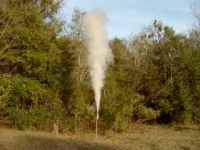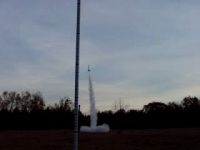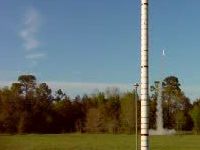Experiments with Recrystallized
KN/Sucrose
BATES Grain PVC Engine - "H" class
Such a clever thing, the Bates grain. I still marvel at the elegance
of this design, and express deep appreciation for those half-dozen or so
Arocket members who helped me understand it.
I have been burning uninhibited hollow-cylinder grains in my PVC engines.
They have worked quite well, on the whole, providing a brief but strong
thrust.
But in playing around with my little VB program for calculating Kn,
I realized that the BATES configuration will allow me to burn almost twice
as much fuel in the same case with a given nozzle. Perhaps it is
a blessing that I have only one decent nozzle, for which I am forever grateful
to Foy. It prompts me to experiment with a variety of grain designs
and configurations to achieve my purposes, while keeping the nozzle dimensions
and case diameter constant.
 |
So the engine begins with the re-heating some recrystallized KN/sucrose
to 200 degrees in the toaster-oven. The various colors are due to
the addition substances to speed the burn rate of slow-burning batches
of propellant. Red is from iron oxide (Fe2O3) a well-known catalyst.
The blue propellant contains some ultramarine (sodium disilicate) which
also accelerates the burn-rate, I believe because it makes the propellant
more opaque. Rcandy by itself ranges
from white to ivory to peanut-butter color, depending upon how much it
is cooked. The longer it cooks, the darker it gets and the slower
it burns. |
 |
You can't quite see it here, but I am sticking down a piece of Scotch
tape, 2 inches wide by about 3 inches long. This is where I will
stand up my grain-mold, so that the propellant will not stick to the plywood. |
 |
Likewise for this strip of manila-folder paper. I coated a sheet
with plastic tape, then cut it into strips 2-1/4 inches wide by 11 inches
long. These will serve as mold-liners for the grains. This
allows me to get them out of the mold without a struggle, and makes the
grains a bit undersized for easy fitting into the engine tube. |
  |
A strip of tape-covered manila-folder paper is rolled up and inserted
into the PVC tube, the taped-side on the inside. These tubes are
short pieces of Schedule 40 PVC, 1-1/4 inch nominal inside diameter (actually
closer to 1-3/8 inch) and cut 2-1/4 inches long. This is a bit too
long for an optimal BATES grain - since these propellant grains end up
being 1.295 inches in diameter, the ideal length would be 2.13 inches. |




 |
A blob of hot propellant is taken from the oven and dropped in the
tube, and pressed down lightly with a dowel. Another drop is added,
and another until the tube is filled almost full. I let it cool a
minute or so, and smooth the top surface with a finger.
This batch is a little moister than most, thus a bit runny.
Cooling it briefly takes care of that.
It may not seem very "scientific" to mix these varigated propellants
without rhyme, reason, or control group, but I just can't help it.
One of the virtues of recrystallized KN/sucrose is that it makes the production
of complex internal grain configurations really easy. I promise to
do some real testing with mixed propellants in the future.
There is a bit of reason for what I am showing here - I put the fastest-burning
propellant at the head-end to facilitate quick ignition. The slower-burning
propellant goes toward the nozzle, assuming that exiting gas will speed
its combustion.
Some day soon I plan to make a core-burning engine with fast-burning
propellant at the core, slower-burning propellant toward the outside to
help "flatten" the thrust-curve.
|
 
  |
A 3/8 inch hardwood dowel is dipped in water and wiped off, leaving
it slightly moist. Then it is inserted into the still-warm propellant
until it reaches plywood at the bottom of the mold. I twist the dowel
a time or two to keep it from sticking. After a couple of minutes
I remove the long dowel and insert a short piece to hold the core open.
An end-cap is placed over the mold to seal it up. This is left until
cooled, 30 minutes or so. |
In the meantime, I can mold more grains. Here are too many photos:




















Sometimes I just stare at the trees.
Please note that although some of the grains are red,
white, and blue, they do NOT represent flags!
(Otherwise I would have to apologize to the citizens of twenty or so
nations for burning their national colors.)


 |
Now that the grains are all ready and the case is ready to receive
them, it is time for the match. Black match is simply cotton string
which has been dipped in a slurry of black powder with a little dextrin.
Allowed to dry, it ignites very easily and burns like a fuse. Thus
I believe it will help to spread flame into the joints between the grains.
It also holds them apart.
This match is made with cotton/polyester cord. It is ugly.
I recommend all-cotton cord. The powder does not stick well to polyester,
so it flakes off leaving uneven coverage. The red grain (test 3/23/02 below)
uses match made with all-cotton string. Note how much better the
match looks.
Now I don't really think this ignition trick is necessary for these
small engines, I'm just doing it here to illustrate the concept, which
might be useful in large engines with hard-to-ignite grains.
|


 |
If you are trying to keeep track of all the colors and where they are
going, please accept my apologies. The photos are a mix-and-match
collection from all three of the engines of this design that I have tested
so far.
I am not sure that the fat ignitor blob will go past all of those match
strings, so it is inserted from the top before gluing on the head-end cap.
The ignitor is an exploding bridge wire inside a piece of masking tape
with 1/4 gram of homebrew black powder.
The finished engine weighs a little over 500 grams, the fuel charge
about 225 grams.
|
Static Test 3/10/02B
 |
The first BATES grain engine is strapped to a skinny fence-post with
three hose clamps.
There is a sinkhole nearby, so I can hunker down when the switch goes
flip.
|
 |
Click on photo for a video of this test.
Beware: 826k download for 5 seconds of video.
Not much hard data except that the burn-time was 1.5 seconds
|
 |
Post-firing (no pun intended.) Note that the PVC casing is deformed
by the middle clamp and the heat of the burn. The pipe gets rather
soft after firing - I am sure the only reason these uninsulted engines
work at all is that it takes time for the heat to disperse through the
plastic. |
Since this engine burned well and did not explode, I decided to try
the same design in a 4x4 launch.
Test 3/10/02C - 4x4 flight
  |
A similar engine is loaded and inserted in my third 4x4 airframe.
I am reluctant to call this a "rocket" as it leads to unrealistic expectations.
So for now it will be called my Gravity-Restrained Vertical Test Sled.
This one is 5 feet long and weighs about 5.8kg with engine. |

Click on the photo above to download a video (.MPG) of this flight
Beware: 1.4 meg download for 15 seconds of video |
Quick summary:
Flight duration:
Thrust duration:
Altitude at apogee:
Fuel Weight:
Nozzle throat:
Launch weight:
Total Impulse: |
8.2 seconds
0.96 seconds
74 meters
220 grams KN/sucrose
5/16 inch
5.86 kg
245 N-sec |
| Despite the appearance, this was not a night launch.
The sun had gone down behind the trees, and the camera adjusted its light
for the much-brighter sky. Visibility was actually quite good, as
you can see in the last few frames of the video and the photos below.
Since I made a bad guess at camera placement, this launch went off-screen,
thus direct measurement of altitude at apogee was not ade. But estimates
taken from flight-time give results very similar to the next test, 3/23/02,
and so are assumed to be accurate.
|
|
|
Autopsy:
So now I want to test this with a effective more inhibitor. Two
weeks pass before I have a day to play.
Test 3/23/02A - 4x4 Flight
Same 4x4 airframe as the previous test, weighing about 12 pounds.

Click on the photo above to download a video (.MPG) of this flight
Beware: 1.4 meg download for 15 seconds of video |
Quick summary:
Flight duration:
Thrust duration:
Altitude at apogee:
Fuel Weight:
Nozzle throat:
Launch weight:
Total Impulse: |
8.3 seconds
1.2 seconds
77 meters
224 grams KN/sucrose
5/16 inch
5.8 kg
257 N-sec |
OR
Click Here for analysis of this launch |
|
|
Side note: You may notice that the airframe seems
to "wobble" as it descends. I think this is an illusion caused by
its spinning. Some time ago Korey Kline asked if the tangential fin
mounting on these devices caused a spin. So I painted one side white
and the other black to make spin more obvious, and have looked for it in
each video. After a number of shots with two different painted airframes,
I am now certain that the airframes do tend spin. Why? Don't
know. Anyone want to enlighten me? Is it differential drag
on the leading edge of each fin that provides a slight angular thrust?
Is my plywood warped, or is it just me?
   |
Thanks to a quick camera adjustment, this test was observed re-emerging
from a wormhole at apogee. I think aliens from the Parallel University
took it up for brief study. Maybe they made it spin as it unrolled
from a tentacle. |
Test 3/23/02A - Autopsy







The double-layer inhibitor seems adequate for this engine. Both
of the lower inhibitors were intact, and the upper one would have been
except that it glued itself to the inside of the PVC and thus could not
be removed in one piece. Interesting that both of these are hardly
scorched on one side, burned almost through on the other. I suspect
the middle one was cracked before I removed it from the casing.
All this brings me to question how exhaust gasses flow around BATES
grains. Until this test I assumed that they would flow wherever they
could, being under high pressure. Also that the Bernoulli effect
would tend towards equalizing the flow. Apparently not. The
inside of the PVC is pristine on one side, scorched on the other.
So the tests will continue. I look forward to hearing any and
all comments on these, as well as suggestions on how to do better testing.

Back to Jimmy's Rocketry Homepage
Jimmy Yawn
jyawn@sfcc.net
minor revisions 12/20/07








